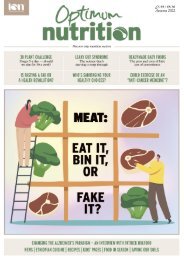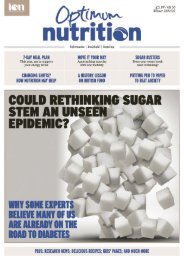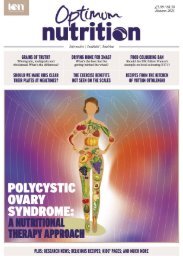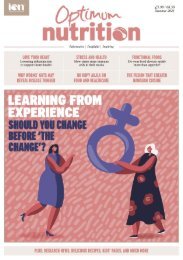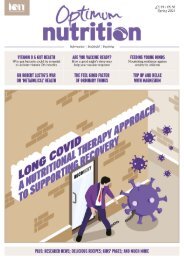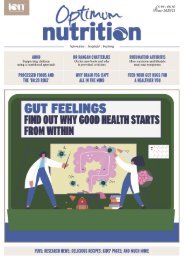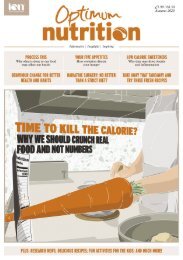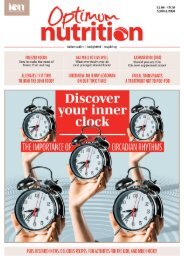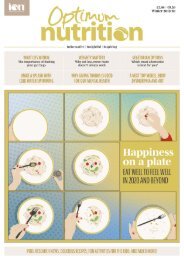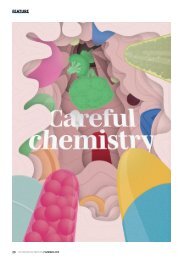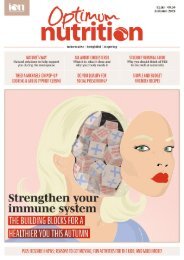What are you hungry for?
Autumn 2020 | Feature From slime mould to humans, ancient appetites for specific nutrients keep us eating — especially when protein is scarce
Autumn 2020 | Feature
From slime mould to humans, ancient appetites for specific nutrients keep us eating — especially when protein is scarce
Create successful ePaper yourself
Turn your PDF publications into a flip-book with our unique Google optimized e-Paper software.
Feature<br />
<strong>you</strong>r appetites — yes, appetites plural.<br />
According to entomologists David<br />
Raubenheimer and Stephen Simpson,<br />
authors of Eat Like the Animals, (see<br />
p.25), living organisms — including<br />
humans — do not eat just to silence<br />
a growling stomach. Instead, they <strong>are</strong><br />
responding to finely tuned appetites <strong>for</strong><br />
specific, essential nutrients. The number<br />
of these appetites depends upon the<br />
animal, from three appetites identified<br />
in locusts (protein, carbohydrate and<br />
sodium) and five in human beings<br />
(protein, carbohydrate, fat, sodium and<br />
calcium). Of these, the most dominant<br />
is <strong>for</strong> protein, driving organisms to<br />
prioritise it over other nutrients and, if<br />
need be, overeating just to get enough.<br />
This doesn’t mean that we should<br />
all start eating masses of protein —<br />
according to Raubenheimer and<br />
Simpson, just 15-20% of our calories<br />
tends to come from protein. <strong>What</strong> it does<br />
mean, however, is that this appetite is<br />
stronger, so many animals — including<br />
humans — will seek out protein over any<br />
other nutrient, and will keep eating until<br />
that 15-20% has been satisfied.<br />
Raubenheimer and Simpson first<br />
observed this in locusts. When locusts<br />
were presented with adequate food<br />
sources, they would eat the locust<br />
equivalent of a nutritionally balanced<br />
diet. But when protein was in short<br />
supply and carbohydrate-rich, low<br />
protein foods were on the menu, the<br />
locusts would overeat until they got<br />
enough protein — even if that meant<br />
becoming overweight.<br />
From slime mould to humans, ancient appetites <strong>for</strong> specific<br />
nutrients keep us eating — especially when protein is scarce<br />
D<br />
o<br />
<strong>you</strong> often eat only to feel<br />
oddly unsatisfied and <strong>hungry</strong> <strong>for</strong><br />
something more, maybe going<br />
on to raid the kitchen cupboards <strong>for</strong> a<br />
snack to fill the gap? If so, it could be<br />
that <strong>you</strong>r food choices <strong>are</strong>n’t satisfying<br />
On humans and locusts<br />
According to Raubenheimer and<br />
Simpson, this phenomenon has also<br />
been observed in humans. In studies<br />
carried out in Switzerland, Jamaica<br />
and Australia, it was found that protein<br />
made up about 18% of what volunteers<br />
ate. But like the locusts, if volunteers<br />
were presented with low protein foods,<br />
they ate more calories — around 35%<br />
more, even though their protein intake<br />
remained the same.<br />
When it comes to understanding our<br />
own food preferences, it may be hard to<br />
comprehend how such innate appetites<br />
might work to drive us towards certain<br />
nutrients: carbohydrates may be sweet,<br />
protein is usually associated with a<br />
savoury taste, and fats tend to have a<br />
creamy mouth-feel. It’s possibly harder<br />
to imagine what calcium tastes or feels<br />
like. Yet, says Raubenheimer, the five<br />
appetites <strong>are</strong> controlled partly by taste<br />
and associated receptors located across<br />
the gut and throughout the body. “The<br />
14 OPTIMUM NUTRITION | AUTUMN 2020
Feature<br />
This could explain why it may<br />
sometimes be so hard to put<br />
down that bag of crisps — not<br />
because it tastes so good…<br />
calcium receptor (CaR) is among these,<br />
and sodium and calcium receptors <strong>are</strong><br />
widespread in the nervous system and<br />
elsewhere,” he says. “There <strong>are</strong> also<br />
associated hormonal signalling systems.”<br />
Raubenheimer and Simpson go on to<br />
suggest that our five appetites may also<br />
be a factor in the growing obesity crisis.<br />
As people across the globe increasingly<br />
consume an ultra-processed diet, high<br />
in carbohydrate and fat, our ancient<br />
appetite <strong>for</strong> protein is going unsated —<br />
or is being sated less quickly. This could<br />
explain why it may sometimes be so hard<br />
to put down that bag of crisps — not<br />
because it tastes so good, but because<br />
our appetite <strong>for</strong> protein isn’t being<br />
satisfied. They suggest that the umami<br />
taste of many processed foods tricks the<br />
brain into perceiving them as a source of<br />
precious protein.<br />
Omega-3s<br />
It has been suggested elsewhere that<br />
a need <strong>for</strong> omega-3 fatty acids could<br />
also be driving consumption through a<br />
similar mechanism. However, Simpson<br />
does not think this is likely. “There is a<br />
fat appetite,” he says.<br />
“More likely that a balance of free<br />
fatty acids is what is being regulated,<br />
not one component [such as] omega-<br />
3s.” The need <strong>for</strong> a balance of fats,<br />
he suggests, is similar to the need <strong>for</strong><br />
a balance of amino acids, which <strong>are</strong><br />
obtained from protein.<br />
<strong>What</strong> Raubenheimer and Simpson<br />
suggest is that rather than focusing on<br />
calories, we should consider the type of<br />
food that we <strong>are</strong> eating. However, <strong>for</strong><br />
anyone struggling with obesity or insulin<br />
resistance, which disrupts ‘normal’<br />
healthy appetite signals, this may need a<br />
reset.<br />
“In some animals [nutrient imbalance]<br />
happens naturally as part of the<br />
seasonal shifts in food abundance and<br />
temperature,” says Raubenheimer. “The<br />
biochemistry simply shifts into states that<br />
support the conditions — hibernation,<br />
fruit abundance, [etc.]. The orang-utans<br />
we discuss in the book is an example;<br />
we’ve studied several other examples<br />
including grizzly bears.<br />
“Evidence in humans is that metabolic<br />
dysregulation in type 2 diabetes can be<br />
reset by a period of fasting and very low<br />
calorie intake.”<br />
A FASTER TRACK<br />
TO METABOLIC<br />
FLEXIBILITY?<br />
F<br />
asting has increased in<br />
popularity as a means to<br />
improve metabolic health and<br />
— as a by-product of that — to lose<br />
weight. It may follow time restricted<br />
feeding, when meals <strong>are</strong> eaten within<br />
a set time frame (e.g. 12 hours or<br />
four hours) or a pattern of fasting<br />
days. However, whatever <strong>for</strong>m it<br />
takes, Amanda Swaine, a registered<br />
nutritional therapist and author of<br />
Intermittent Fasting <strong>for</strong> Beginners, says it<br />
is not the same as a low calorie diet.<br />
Switching from feast to famine<br />
“Intermittent fasting works<br />
differently… by switching between<br />
periods of very few calories (fasting)<br />
to periods of abundant calories<br />
(feasting),” she says. “This…stops<br />
the body from thinking starvation is<br />
coming and slowing the metabolic rate<br />
as a protection mechanism.”<br />
One of the benefits, she says, is<br />
“metabolic flexibility”, with the body<br />
being able to transition between using<br />
carbohydrates, fats or proteins <strong>for</strong><br />
energy — so “the body can meet its<br />
energy needs in accordance with how<br />
it evolved; using glucose-based energy<br />
as the main fuel <strong>for</strong> short term needs<br />
and internal fat stores <strong>for</strong> longer term<br />
energy needs”.<br />
Other benefits include helping to<br />
resolve chronic inflammation and<br />
increased sensitivity to the hormones<br />
insulin and leptin. This, she explains,<br />
enables cells to use blood glucose<br />
more effectively and enables the brain<br />
to ‘see’ and utilise fat stores from<br />
around the body.<br />
<strong>What</strong>ever plan <strong>you</strong> choose, however,<br />
Swaine says to eat during or as<br />
close to daylight hours as possible.<br />
“Interestingly, the body adapts more<br />
easily to skipping a meal than having<br />
one at a wildly different time than<br />
usual,” she says.<br />
Pack in good nutrition<br />
She also emphasises the importance<br />
of not adopting a diet mentality. “It is<br />
important to focus on eating enough<br />
and eating healthily during the eating<br />
phase,” she says. “Some people notice<br />
they <strong>are</strong>n’t as <strong>hungry</strong>…after they have<br />
adjusted to their fasting regime and<br />
eat a lot less than normal, thinking this<br />
will speed up weight loss and the other<br />
benefits of fasting.<br />
“If this becomes a regular<br />
occurrence, over time they could<br />
experience a similar effect on their<br />
BMR (see p.10) to that experienced<br />
during long term, low calorie diets.”<br />
She also warns against eating<br />
ultra-processed foods. “Some people<br />
think they can eat whatever they like<br />
during the eating phase,” she says.<br />
“If the diet is low in nutrients and<br />
highly processed, <strong>you</strong> may be driven<br />
to overeat as the body sends out<br />
strong hunger signals in an attempt to<br />
get the nutrients it needs.” She also<br />
recommends adding in some weight<br />
training to help boost the BMR.<br />
However, while she says fasting<br />
may benefit most adults she adds that<br />
it is not suitable <strong>for</strong> people who <strong>are</strong><br />
underweight, who have or previously<br />
had an eating disorder, <strong>are</strong> pregnant,<br />
chronically stressed, experience<br />
hypoglycaemia or low blood pressure,<br />
have type 1 diabetes or need to take<br />
medication with meals several times a<br />
day at set times that can’t be adjusted.<br />
She advises that anyone taking<br />
medication, such as <strong>for</strong> type 2 diabetes<br />
or thyroid conditions, should seek<br />
medical advice be<strong>for</strong>e starting a fasting<br />
regime. She also recommends that<br />
women who <strong>are</strong> breast feeding or<br />
people over 70 work with a practitioner<br />
to ensure they <strong>are</strong> getting adequate<br />
nutrients.<br />
For those who have a history of low<br />
calorie dieting, she says that weight<br />
related benefits may take longer to<br />
achieve. “The good news <strong>for</strong> those<br />
people is, with the right fasting<br />
and eating plan…their body will be<br />
becoming more metabolically flexible.”<br />
WHAT TO WATCH OUT FOR<br />
• Do not adopt a ‘diet’ mentality<br />
• Do not cut food to speed weight loss<br />
• Avoid ultra-processed foods<br />
• Aim <strong>for</strong> good quality nutrition<br />
• Seek medical advice be<strong>for</strong>ehand<br />
• Consult <strong>you</strong>r GP about any<br />
medication <strong>you</strong> <strong>are</strong> already taking<br />
OPTIMUM NUTRITION | AUTUMN 2020<br />
15
Enjoyed reading this article?<br />
Subscribe and read the full digital magazine <strong>for</strong> free at ion.ac.uk/digital<br />
www.ion.ac.uk | info@ion.ac.uk | 020 8614 7800 | institute<strong>for</strong>optimumnutrition | @ion_nutrition | @ion_nutrition<br />
Institute <strong>for</strong> Optimum Nutrition is an independent educational charity. Registered company number 2724405, registered charity number 1013084




